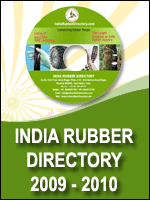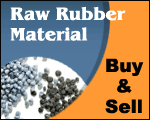PRECIPITATED SILICA
By Dr. Samir Majumdar
Flat: H-701, Neel Padam Kunj, Vaishali, Opp. Dabur Chawk
Ghaziabad, Uttar Pradesh.
INTODUCTION
World wide there are four major products based on silica: precipitated Silica,
Silica gel, fumed silica, and colloidal silica. Silica is a versatile inorganic
chemical which is used for reinforcement of rubbers and plastics. Thickening and
thixotropy of coating and paints, printing inks and cosmetics, anti blocking of
plastic foils, free running and free flow of sticky solid and liquid substances,
carrier for pesticides, insecticides, high temperature insulation, stabilizing
of beer and in silicon rubber as reinforcing filler. It imparts good finish,
strength and balances at the required physico-chemical properties of the
products.
Precipitated silica is manufactured from Sodium silicate, which is dissolved in
water to prepare the required concentration and is then reacted with dilute
sulphuric acid of known concentration in presence of coagulating agent.
Precipitated silica is produced by a chemical reaction in an aqueous solution
from sodium silicate with a mineral acid or Aluminium sulphate (for sodium
aluminium silicate). This reaction takes place in an aqueous solution and the
initially formed primary particles of 15-30nm are agglomerated to a loose
structure, which finally determines the physical properties of the produced
silica. By varying the precipitation conditions a broad variation of products
can be produced, with a large number of applications.
After precipitation the precipitated silica is filtered, washed and dried. After
a further milling-and an optional granulation step the Grace Davison
Precipitated Silica and sodium aluminium silicates are ready for shipment.
Industrial sand and gravel, often called “Silica”, “Silica sand”, and “quartz
sand”, includes sands and gravels with high silicon dioxide (SiO2) content.
These sands are used in glassmaking, for foundry. Abrasive, and hydraulic
fracturing applications; and for many other industrial uses. The specifications
for each use vary, but silica resources for most uses are abundant. In almost at
cases, silica mining uses open pit or dredging mining methods with standard
mining equipments.
Except for temporarily disturbing the immediate area while mining operations are
active, sand and gravel mining usually has limited environmental impact. The
chemical compound silicon dioxide, also known as silica, is the oxide of
silicon, having chemical formula: SiO2.
It is found in nature in several forms, including quartz and opal. In fact,
silica has 17 crystalline forms. Also, many forms of life include silica
structures, including microorganisms such as diatoms, plants such as horsetail
and animals such as hexactinellid sponges.
It is manufactured in several forms including glass (in colorless very high
purity form), synthetic amorphous silica and silica gel (Used e.g.as desiccants
in brand new clothes and leather goods). Silica is a major ingredient of port
land cement. The ceramic re-entry heat protection tiles mounted on the bottom
side of the space shuttle are made mostly of silica, as are the fire bricks used
in steel processing. Inhaling crystalline silica dust can lead to silicosis.
PRECIPITATED SILICA
Silica has two main varieties (a) Ground silica and (b) Processed silica. Ground
silica is practically sand and is abundant in India and world wide only the
percentage of SiO2 varies from source to source. In general these are known as
sands and are very cheap and usually used for glass making. It has very minimum
use in rubber, however, can be used as heat resistant compound in rubber. It
does not show any effect on cure.
Processed silica is again SiO2 but in a purified form. This is obtained only
after further processing from ground silica and in such process the percentage
of SiO2 is increased considerably (>98%).
Precipitated silica is a kind of processed silica only. In this method, silica
is precipitated after acidification of alkaline silicate solution. There are
three different types of reactions, possible:
• The alkaline silicate solution flows into the acid solution.
• The acid solution flows into the alkaline silicate solution.
• The alkaline silicate solution and acid solution flows jointly into water or
primary natural salt solution.
The first process (a) is not suitable for the production of reinforcing silica
filler because the silica sols develop in the acidic medium coagulates n
gelatinous form. This process, however, preferred for the production of silica
gel.
Infact, precipitated silica is produced from the second method (b). The acid
flow into the alkaline silicate solution and the pH value is maintained at 11.0.
when the alkaline solution is acidified, silica separates out spontaneously and
this process results in producing very uniform particle size. The only
disadvantage in this process is silica separation takes place in the form of
coarse flocculent, resulting viscosity of the suspension rising sharply.
The third process ©, is often employed to take care of the disadvantages on the
process (b) In other words this process is used to control the pH value of
process (b).
Precipitated silica is actually precipitated silicic acid is then finally washed
and dried. These are essentially SiO2 yet containing 10-14% of combined water,
with particle size 10-14nm. These are often used as highly reinforcing inorganic
filler in elastomers and provides high degree of tensile strength, tear
strength, abrasion resistance and hardness in vulcanizate. When used in
combination with carbon black, it also improves upon tear resistance and
adhesion with fabric. A flow sheet diagram for the production of precipitated
silica is given below:
SodiumSilicate Solution + sulphuric
_Precipitation
Ü
Milling
`
Spray Drying
` Washed
` Filteration
Ü
Storage
Silos _Bagging
_
Transportation
Precipitated silica is often used when high reinforcing white or light coloured
rubber article is required to be manufactured. Use in white sidewall of tyre is
very common and recently with green tyre revolution, as a future tyre for clean
environment. Silica based coloured tyre is playing major role in European
market. However, use of such tyre is limited because of higher cost of these
tyres.
APPLICATIONS
Precipitated silicas are mainly used as a reinforcement agent in rubber and tyre
formulations. They are additionally utilized as carriers. Anti-caking or
free-flow agents in consmetics and food applications and as abrasive or
thickener in toothpaste’s and cosmetics.
Infact, the uses of precipitated silica in rubber applications are more,
whereas, the volume used in non rubber industry will be much higher. In India,
use of rubber; non rubber will be 70:30 approximately: whereas, world wide the
above ratio is close to 55:45
Use in Rubber:
Rubber rice rollers
Conveyor belts
Transmission belts
Hoses
Footwear
Railway Pads
Tyres
Silicone Rubber
In silicone rubber, however, fuming silica has wide application. Use of fuming
silica, which is another kind of processing silica has very limited applications
because of its higher price and presently, it is mostly tried in silicone based
compounds.
Products formulated with one hundred percent use of precipitated silica in
Indian Rubber compounding, however, is very rare, unless one attempts a
colourful reinforced rubber compound. In India, major use of precipitated silica
is with carbon black, replacing a part of it where additional tear resistance
and abrasion resistance are important.
Use in non rubber:
Free flow salts
Talcum Powder
Toothpaste
Pan masala
Creams
Pesticides
Detergents
Ink
Paints
Toners
Cosmetics
Pharmaceuticals
Plastics.
Precipitated silica is widely marketed in free flowing powder that improves free
flowing properties of the products like salt, detergent, talcum etc. It is also
used as anticaking agent that absorbs the moisture and make the detergent light
also making it bulk.
Chewing pan is very pleasure mouth freshener used in all over India but many do
not know that a wide range of pan masala is actually made with edible
precipitated silica.
RUBBER COMPOUNDING OF SILICA
Compounding with silica is different from carbon black and also difficult.
Difficult because it takes comparatively longer time in the mixing mill to have
comparable dispersion level and due to its fluffy nature there is tendency of
fly loss and there is also chance of pollution in the environment.
Fluffy silica, due to its hydrophilic property, becomes more incompatible with
rubber. Silica to silica bond reported to become comparatively higher resulting
larger aggregates which causes impending in flow and the mix becomes very stiff.
The major incompatibility of silica is due to its inorganic nature, not
compatible with elastomers, which are mostly organic in nature.
It is different because silica has much more reactive surface than carbon black.
The addition of silica in rubber compound rapidly shows increase in Mooney
viscosity. The maximum dose of silica is normally maintained close to 50 phr. In
a SBR 1500 compound. With 15 phr of softener and 55 ph or silica may raise
Mooney viscosity close to 90 unit (ML1=4@100C). The early addition of silica
along with zinc oxide results in lowering in Mooney viscosity and helps in
lowering compound modulus.
Addition of silica in rubber, tend to increase rubber viscosity compared to
other filler, therefore, additives are chosen to take care of this increase in
viscosity. A few such additives are:
Zinc Octoate (or other soluble zinc Compounds
Hexamethyltetramie (HMT)
Magnesium oxide etc.
Compound viscosity and cure rate is dependent on the adsorbed moisture on
silica. Moisture in silica behaves like a psudeo-plasticizer and cure activator.
The moisture in silica can vary in the humid condition and also in processing
condition. Mixing for silica filled compound should be handled with care. Due to
higher dump temperature of the compound. If the moisture content of silica goes
below 3% adequate dispersion might be difficult to obtain.
Most frequently used accelerator systems are severely deactivated by silica
filler due to their higher surface area. As a result, with loading around 15 phr
of silica, 1-2 phr of diethyl glycol (DEG) or poly ethylene glycol (PEG 4000) is
added to reduce the effect of deactivation. Tri ethanolamine is also used for
its activating effect.
A precipitated silica with surface area (BET) of 220 m sq./g may have may have
only 150m,. sq/g electron microscopy. Because of this porous nature of silica,
it will tend to adsorb accelerators and make less effective than carbon black.
Higher tear strength is a common character with silica. High tear strength also
increases with increase in silica surface area. Silica filled compound shows its
characteristics of irregular tear rupture, very much different from carbon black
filled rupture and this phenomenon is often called as “Knotty tear” in rubber
industry. A wide variety of curing systems are used with silica, depending on
the polymers used and the properties wanted.
Mercapto-propyltrimethoxy silane
Bis 3- (triethoxisilyl) Propyl tetrasulfane
Coupling agents are popularly known as silane coupling agent. Coupling agent
acts as bonding agent between rubber and filler.
Precipitated silica is extensively used in various elastomers, close to 70% of
its total production. Other 30% use is in non rubber use like toothpaste, glues,
pan masala (in India) and other as a carrier for liquid active ingredients.
Those used in rubber applications are eventually having surface area in the
lower end of the scale, not more than 190 m sq/g. rubber grade silica contains
10-14% water, as already been specified, with particle size 10-14 nm, helps in
better bonding and dispersion in rubber.
Depending on the polymers used and compounding techniques, a wide variation of
properties can be obtained using silica, in silica based filler system tensile
strength can be increased up to 4200psi, elongation up to 850% hardness can be
in between 40-80 shore A.
EXPOSURE TO SILICA
Silicosis is a disabling, nonreversible and sometimes fatal lung disease caused
by overexposure to respirable crystalline silica. More than one million U.S.
workers are exposed to crystalline silica and each year more than 250 die from
the deadly disease known as “silicosis”
There is no cure for the disease, but it is 100 percent preventable if
employers, workers, and health professionals work together to reduce exposures.
The following questions link to resources that provide safety and health
information relevant to silica, crystalline.
The health hazards of silica come from breathing in the dust. Activities, which
can expose workers or members of the public to the dust, include.
Stone masonry;
Façade renovation;
Blast cleaning of buildings, especially using sand;
Many demolition processes
Concrete scrabbling cutting or drilling
Tunneling;
Rubber mixing;
The use of power tools to cut or dress stone will lead to high exposures will
often depend upon how confined the working space is, the presence or absence of
ventilation and how near the worker’s breathing zone is to the source of the
dust. Tunneling through dry. Silica-bearing rock will always lead to high
exposures for workers at or near the cutting face.
Use of silica in rubber industry in comparatively safe if internal mixers are
used. However, PPE (Personal Protective Equipments) and the use of mask is
compulsory for the employees working in the mixing area.
Health Effects
Breathing in the very fine dust of crystalline silica can lead to the
development of silicosis. This involves scarring of the lung tissue and can lead
to breathing difficulties. Exposure to very high concentrations over a
relatively short period of time can cause acute silicosis resulting in rapidly
progressive breathlessness and death within a few months of onset. Similarly,
accelerated silicosis, which can progress to death within a decade, has been
associated with high exposures to silica in sand blasting.
More common is progressive silicosis, usually because of exposure over a longer
period. This causes fibrosis (hardening or scarring) of the lung tissue with a
consequent loss of lung function. Victims are likely to suffer severe shortness
of breath and will find it difficult or impossible to walk even short distances
or upstairs.
The effect continues to develop after exposure has stopped and is irreversible.
Sufferers usually become bed-bound and often die prematurely due to heart
failure. Silica may be linked to lung cancer. If this is the case it is most
likely that it occurs as a progression of lung fibrosis. Precautions taken to
control the risk of fibrosis will serve to control the risk of lung cancer.
Legal requirements
In the advanced countries, silica has been assigned a maximum exposure limit
(MEL) of 0.3 mg/m3 expressed as an 8 hour time weighted average (TWA). The means
that exposure to respirable crystalline silica should be reduced so far as is
reasonably practicable and, in any case, below the MEL.
Precautions
Activities that may expose workers to silica are subject to the control of
substances hazardous to health regulations, which require the health risk to be
assessed and then prevented or controlled. In most cases, when it is reasonable
to expect dust levels to be significant one should consider the need for
atmospheric sampling of respirable dust and respirable silica.
As a general rule, levels greater than 0.1 mg/m3 can be regarded as significant.
In cases of doubt it should usually be assumed that levels will be significant
unless sampling from very similar work has shown otherwise.
Results of sampling may be needed to find out the control measures that will be
appropriate for a particular activity. As well as evaluating the risk and
describing the precautions, the assessment should set out in detail the way in
which the control measures are to be monitored, supervised and maintained.
Personal Protective Equipment
These control techniques may not always be appropriate or they might not reduce
exposure sufficiently, so respiratory protective equipment (RPE) often has to
provide as well. You will need to select RPE very carefully as different types
can give widely varying standards of protection. Surveys of respirable dust and
respirable silica levels are usually necessary to ensure correct selection.
For the dustiest processes, positive pressure or airline breathing apparatus
will probably be necessary. Remember that filtering face piece or half-mask
respirators give little or no protection to men with beards and that even a
minor growth of stubble can severely reduce the effectiveness of RPE.
Remember that workers need to be properly trained in the use for RPE and that a
high standard of supervision, inspection and maintenance will also be needed.
Suitable protective clothing should be provided to prevent contamination of
worker’s own clothing. Those who need to wear PPE should be trained in its
proper use and in its limitations. Store the equipment in clean, dry conditions
away from chemicals-a locker would be suitable. PPE should be maintained and
kept clean and fit for wear.
Facilities for washing and changing should be available on site and workers
should wash their hands before eating, drinking, smoking and going to the
toilet. Eating, drinking and smoking should take place away from the work area.
REFERENCE
• http://www.silica.com, February5
• http://www.osha.gov/SLTC/constructionsilica, March 2005
• http://enande.lbl.gov/ECS/aerogel, April 2005
• Non Black filler, samir Majumdar, Rubber News (15-25) August 1999.


























